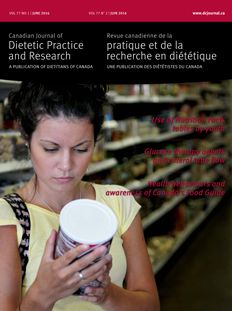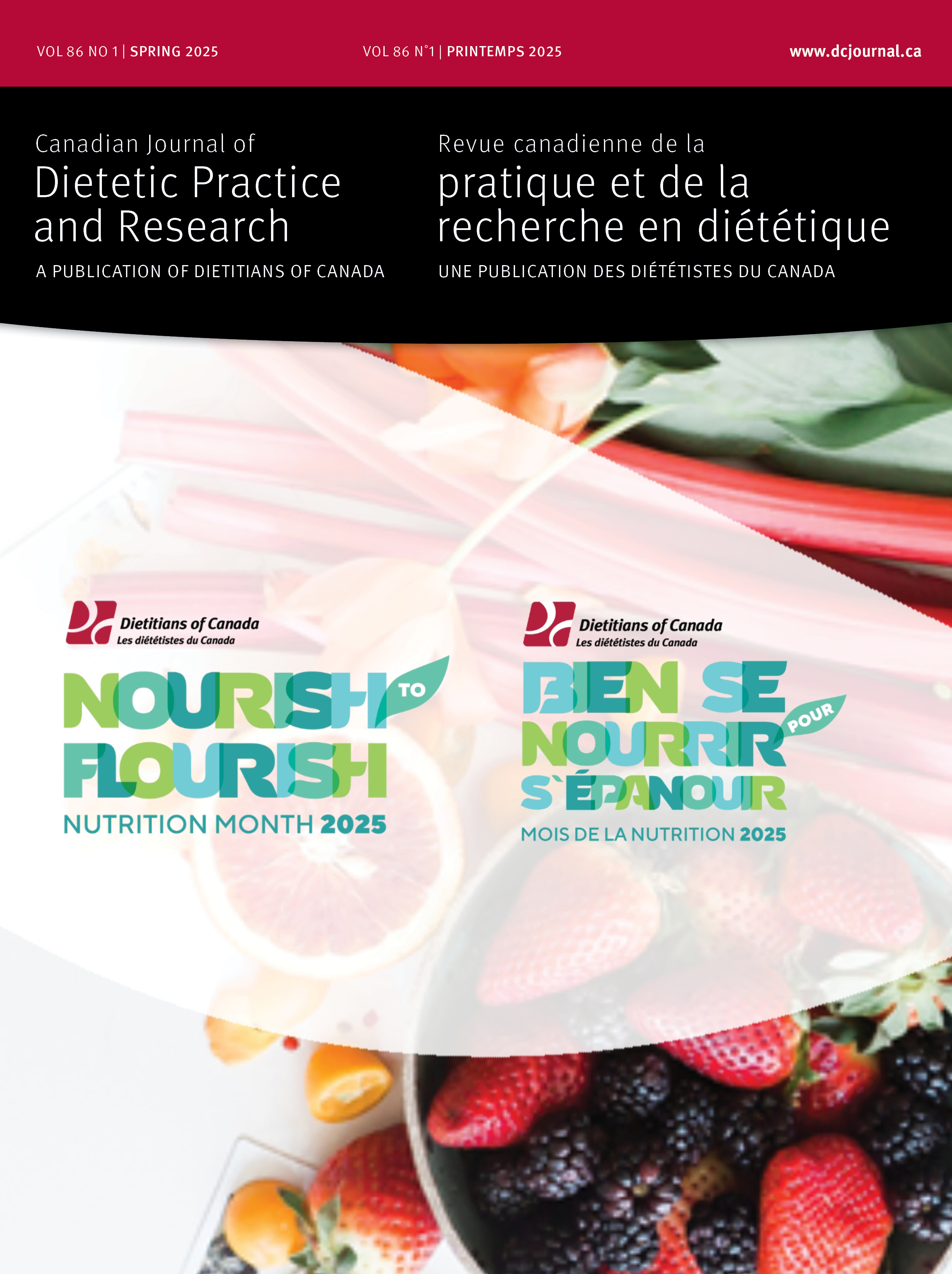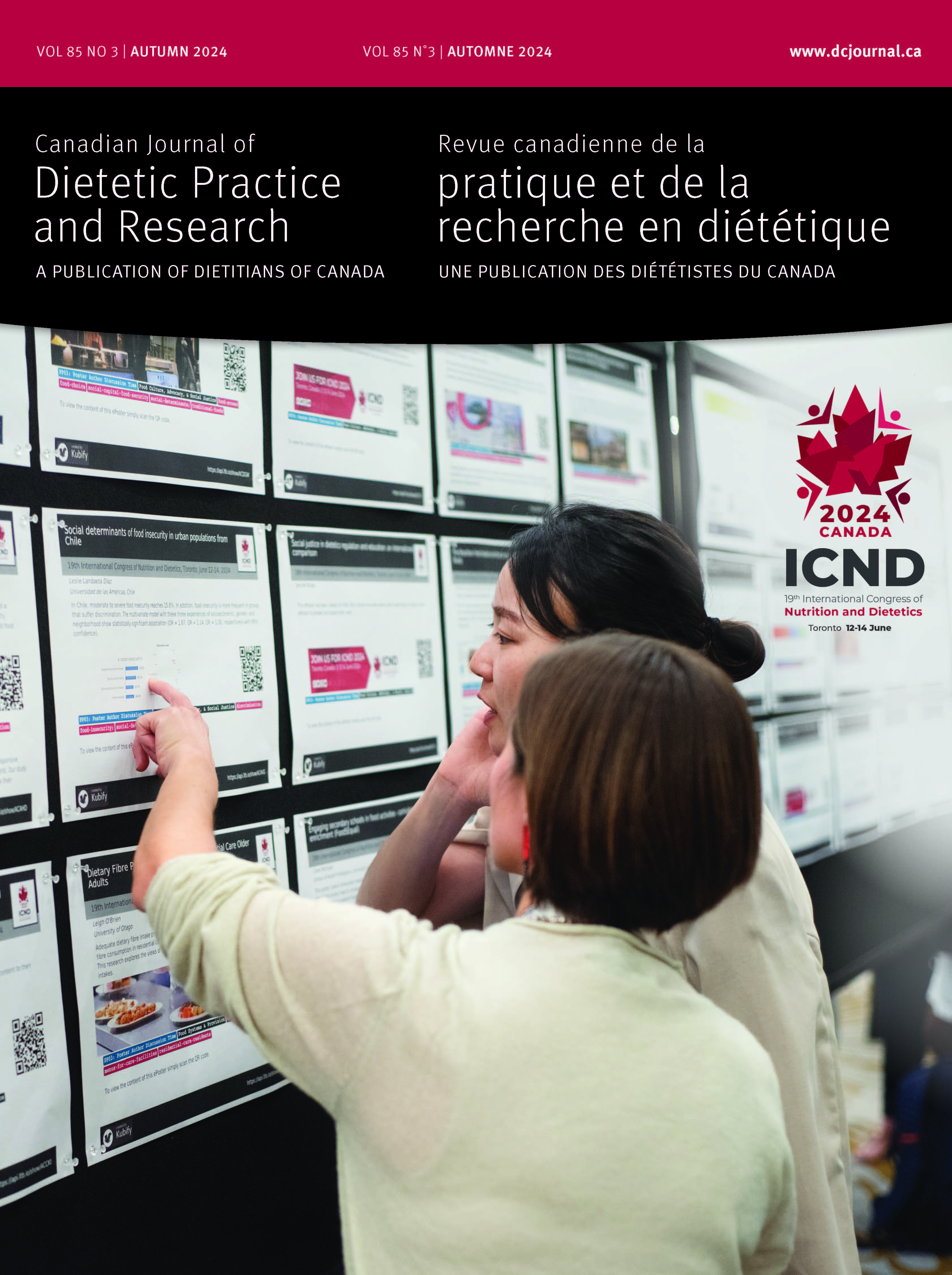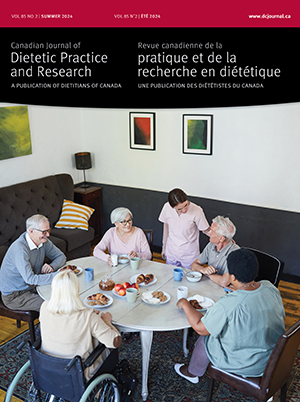Volume 77 • Number 2 • June 2016
Chair's Message
Editor's Message
Research
Purpose: Limited evidence exists on the comprehension and use of Nutrition Facts tables (NFt) among adolescents and young adults. This study provides an account of how young people engage with, understand, and apply nutrition information on the current and modified versions of the NFt to compare and choose foods. Methods: Participants aged 16–24 years (n = 26) were asked to “think aloud” while viewing either the current or 1 of 5 modified NFts and completing a behavioural task. The task included a questionnaire with 9 functional items requiring participants to define, compare, interpret, and manipulate serving size and percentage daily value (%DV) information on NFts. Semi-structured interviews were conducted to further probe thought processes and difficulties experienced in completing the task. Results: Equal serving sizes on NFts improved ability to accurately compare nutrition information between products. Most participants could define %DV and believed it can be used to compare foods, yet some confusion persisted when interpreting %DVs and manipulating serving-size information on NFts. Where serving sizes were unequal, mathematical errors were often responsible for incorrect responses. Conclusions: Results reinforce the need for equal serving sizes on NFts of similar products and highlight young Canadians’ confusion when using nutrition information on NFts.
Purpose: Lifestyle behaviours among adults reporting awareness of Canada’s Food Guide (CFG) are described. Methods: Data from a cross-sectional survey of adults from Alberta were used to estimate the prevalence of reported health behaviours among respondents aware of the CFG. Results: Respondents (n = 1044) reported general awareness of CFG (mean age 50.3 years; 54.2% female) of whom 82.2% reported awareness of specific CFG recommendations. Respondents reported frequently reading food labels (>58.0%), reading the number of calories (45.5%), the amount of sodium (49.5%), the amount of fat (46.7%), and the type of fat (45.5%) on the food label. Most respondents (90.0%) reported frequently selecting foods to promote health. Approximately one-third of the respondents (35.8%) reported frequently consuming ≥5 portions of vegetables and fruit per day and regularly participating in physical activity (55.3%). Body weight was perceived as healthy by 63.4% of the respondents. Most engaged in 2 health behaviours frequently. Adjusting for important socio-demographic characteristics, those who reported frequently consuming ≥5 portions of vegetables and fruit per day were more likely to engage in a second health behaviour outlined in CGF (OR: 23.6, 95% CI (16.2–34.4)). Conclusion: Awareness of CFG did not translate to positive health behaviours. More proactive population level strategies to support specific health behaviours as outlined in CFG might be warranted.
Purpose: To date, baby-led weaning (BLW) has not been examined in a Canadian population. This research investigated common BLW practices and compared associated knowledge and perceptions of practicing mothers and health care professionals (HCPs). Methods: Sixty-five mothers practicing BLW and 33 HCPs were surveyed using 2 online questionnaires. Mothers were recruited through the Newfoundland and Labrador BLW Facebook page and HCPs via email at 2 regional health authorities. Results: Mothers described BLW in terms of food shape and consistency (whole, solid); however, in practice, some mothers offered puréed foods such as infant cereals. More HCPs than mothers indicated choking, inadequate energy, and iron intake as concerns. Mothers relied on the Facebook page over HCPs for BLW information and support. Although all practicing mothers would recommend BLW to others, less than half (48.5%) of HCPs would support it in their practice. Conclusions: Mothers following BLW vary greatly in their experiences and adherence to BLW. They view the practice and its disadvantages very differently than HCPs. Although most HCPs were aware of BLW, few were familiar with specific practices. HCPs may benefit from a greater understanding of BLW to provide guidance to the growing number of mothers following this practice.
Purpose: The purpose of this, the third phase of a 3-phase research project, was to develop guidelines for client-centred nutrition education (NE). Methods: A 3-phase study was conducted using a progressive development design, where each phase informed the subsequent phase. Phase 1 was a national online survey of dietitians’ perceptions of consumers’ NE needs and preferences; results informed the Phase 2 national online survey of consumers about their NE needs and preferences. Phase 3 involved national 2-part teleconference consultations with dietitians to discuss implications of the Phase 2 findings for NE practice. This paper is the report of Phase 3. Results: Discussion group participants were 22 dietitians from around Canada who had been in practice for an average of 14.5 years. Discussions resulted in the development of the Collaborative Client-Centred Nutrition Education (3CNE) conceptual framework and related Practice Points that explicate the complexity of NE practice. Conclusion: The 3CNE framework and Practice Points provide a means to inform precepting students and interns, and for use in planning for the professional development of practicing dietitians on providing client-centred NE.
Perspectives in Practice
We examined the impact of an optional experiential learning activity (ELA) on student engagement and performance in 2 undergraduate nutrition courses. The ELA involved completion of a 3-day food record, research lab tour, body composition assessment, and reflective take-home assignment. Of the 808 students in the 2 courses (1 first-year and 1 second-year course), 172 (21%) participated. Engagement was assessed by the Classroom Survey of Student Engagement (CLASSE), and performance was assessed by percentile rank on midterm and final exams. Students’ perceived learning was assessed using a satisfaction survey. Paired-samples t tests examined change in CLASSE scores and percentile rank from baseline to follow-up. Frequencies and thematic analysis were used to examine responses to Likert scale and open-ended questions on the satisfaction survey, respectively. There was an 11%–22% increase (P < 0.05) in the 3 dimensions of student engagement and a greater increase in percentile rank between the midterm and final exams among participants (7.63 ± 21.9) versus nonparticipants (−1.80 ± 22.4, P < 0.001). The majority of participants indicated the ELA enhanced their interest and learning in both their personal health and the course. Findings suggest ELAs related to personal health may improve interest, engagement, and performance among undergraduate students.
The purpose of this project was to develop and content validate both a formative and summative self-assessment scale designed to measure the nutrition and physical activity environment in community-based child care programs. The study followed a mixed-method modified Ebel procedure. An expert group with qualifications in nutrition, physical activity, and child care were recruited for content validation. The survey was subjected to expert review through digital communication followed by a face-to-face validation meeting. To establish consensus for content validity beyond the standard error of proportion (P < 0.05) the content validity index (CVI) required was ≥0.78. Of the initial 64 items, 44 scored an acceptable CVI for inclusion. The remaining items were discussed, missing concepts identified, and a final CVI employed to determine inclusion. The final tool included 62 items with 5 subscales: food served, healthy eating program planning, healthy eating environment, physical activity environment, and healthy body image environment. Content validation is an integral step in scale development that is often overlooked or poorly carried out. Initial content validity of this scale has been established and will be of value to researchers and practitioners interested in conducting healthy eating interventions in child care.
To develop evidence-based hypoglycemia treatment protocols in patients receiving total enteral nutrition, this study determined the effect on enteral tube flow of glucose therapy agents: apple juice, orange juice, and cola, and it also examined the effects of tube type and feed type with these glucose therapy agents. For this study, 12 gastrostomy tubes (6 polyethylene and 6 silicone) were set at 50 mL/h. Each feeding set was filled with Isosource HN with fibre or Novasource Renal. Each tube was irrigated with 1 glucose therapy agent, providing approximately 20 g of carbohydrate every 4 h. Flow-rate measurements were collected at 2 h intervals. The results showed that the glucose therapy agent choice affected flow rates: apple juice and cola had higher average flow rates than orange juice (P = 0.01). A significant difference was found between tube type and enteral formula: polyethylene tubes had higher average flow rates than silicone tubes (P < 0.0001), and Isosource HN with fibre had higher flow rates than Novasource Renal (P = 0.01). We concluded that apple juice and cola have less tube clogging potential than orange juice, and thus may be considered as primary treatment options for hypoglycemia in enterally fed patients. Polyethylene tubes and Isosource HN with fibre were less likely to clog than silicone tubes and Novasource Renal.
Report
Purpose: To describe body composition (fat mass (FM) and fat-free mass (FFM)), strength, and nutritional characteristics of patients with hip or knee osteoarthritis undergoing total joint arthroplasty. Methods: In this prospective pilot study, osteoarthritic patients underwent body composition assessment using bioelectrical impedance analysis, grip strength measurement, and completed a 24-h dietary recall during their pre-operative assessment. Results: Fifty-five patients were included (∼66% females, age 43–89 years). Mean ± SD body mass index (BMI) was 32.79 ± 6.48 kg/m2 and 62% were obese. Compared with hip osteoarthritis patients, knee osteoarthritis patients had a higher BMI (P = 0.018) and males with knee osteoarthritis had a lower grip strength (P = 0.028). There was a wide range in FM and FFM values across the BMI spectrum. Patients with a higher FM index (FMI, FM/height in m2) had higher levels of pain (P = 0.036) and females with higher FMI had a lower grip strength (P = 0.048). Dietary under-reporting was common and many patients did not meet recommendations for protein, vitamins C and E, or omega-3 fatty acids. Those who consumed less protein than the recommended dietary allowance were older (P = 0.018). Conclusions: A wide variability of body composition and dietary intake was observed which may impact strength and ultimately affect physical function. As such, patients with osteoarthritis may benefit from targeted nutrition and physical activity interventions before and after surgery.
Purpose: It is commonly suggested that calcium supplementation contributes to constipation; however, little research has explored the effects of calcium supplementation on gut motility. Methods: In an 8-week, randomized, double-blind, crossover pilot study, healthy females (n = 27, aged 43.0 ± 10.6 years) received a split dose of 500 mg/d of elemental calcium from calcium carbonate or calcium phosphate each for 2 weeks, after a 2-week baseline and separated by a 2-week washout. Participants completed daily questionnaires of stool frequency, Bristol Stool Form Scale (BSFS), and supplement intake compliance. Results: There were no differences among periods. Mean ± SE stool frequency averaged 1.3 ± 0.1 stools/d in each period. Participants reported 34%, 34%, 37%, and 29% of stools were indicative of slow transit or constipation (BSFS of 1 or 2) during baseline, calcium carbonate, calcium phosphate, and washout periods, respectively. Participants also reported from 6% to 10% of stools as fast transit or diarrhea (BSFS of 6 or 7) during the periods. Conclusion: This study suggests that neither calcium carbonate nor calcium phosphate, providing 500 mg/d of calcium, affects stool frequency or form. Although stool frequency was normal, the healthy females participating in the study experienced stools indicating slow (constipation) and fast (diarrhea) transit.
Purpose: To describe dietary intake associated with intentional weight gain among grade 7 students. Methods: Data were collected using the Waterloo web-based Eating Behaviour Questionnaire (WEB-Q) and measured heights/weights were taken to assess Body Mass Index (BMI). Dietary intake and the Canadian Healthy Eating Index-2009 were compared among participants who ate more to gain weight. Results: Among 1015 participants, approximately 9% of participants were actively attempting to gain weight with more males than females (P < 0.001) and more underweight and normal weight than overweight/obese (P < 0.001) participants. Unadjusted analyses revealed that weight gainers versus non-weight gainers consumed more grain products (P < 0.001), meat and alternatives (P = 0.005), and other foods (P < 0.001), in addition to more total energy (P < 0.001). Although greater amounts of carbohydrates, fat, and protein were consumed among the weight gainers, no differences in the percentage of each macronutrient were observed once corrected for total energy intake. The adjusted model revealed that weight gainers were more likely to consume grain products in line with current recommendations, yet they were further from the recommendations for total fat intake. Conclusion: Health promotion strategies need to consider intentional weight gain among young adolescents to ensure that appropriate weight gaining strategies are being followed to avoid potential detrimental health effects.
Public Policy Statement
OPEN ACCESS
Dietitians of Canada recommends that an excise tax of at least 10–20% be applied to sugar-sweetened beverages sold in Canada given the negative impact of these products on the health of the population and the viability of taxation as a means to reduce consumption. For the greatest impact, taxation measures should be combined with other policy interventions such as increasing access to healthy foods while decreasing access to unhealthy foods in schools, daycares, and recreation facilities; restrictions on the marketing of foods and beverages to children; and effective, long-term educational initiatives. This position is based on a comprehensive review of the literature. The Canadian population is experiencing high rates of obesity and excess weight. There is moderate quality evidence linking consumption of sugar-sweetened beverages to excess weight, obesity, and chronic disease onset in children and adults. Taxation of sugar-sweetened beverages holds substantiated potential for decreasing its consumption. Based on economic models and results from recent taxation efforts, an excise tax can lead to a decline in sugar-sweetened beverage purchase and consumption. Taxation of up to 20% can lead to a consumption decrease by approximately 10% in the first year of its implementation, with a postulated 2.6% decrease in weight per person on average. Revenue generated from taxation can be used to fund other obesity reduction initiatives. A number of influential national organizations support a tax on sugar-sweetened beverages.










